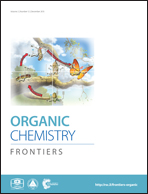Organopolymerization of naturally occurring Tulipalin B: a hydroxyl-functionalized methylene butyrolactone†
Abstract
The first successful polymerization of the naturally occurring, OH-containing, tri-functional monomer Tulipalin B (βHMBL) is established. N-Heterocyclic carbene and phosphazene superbase catalysts effectively polymerize βHMBL into polymers with Mn up to 13.2 kg mol−1. The possible polymer structure is thought to be a branched copolymer of poly(vinyl-ether lactone)s, derived from proposed crossovers between conjugate Michael and oxa-Michael additions, enabled by proton transfer.

- This article is part of the themed collection: Carbenes for Today

 Please wait while we load your content...
Please wait while we load your content...